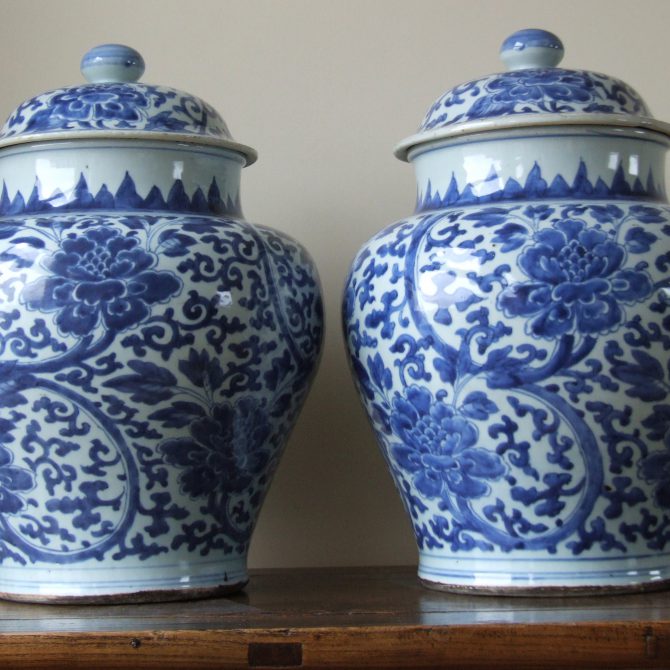
KANGXI 1662 – 1722 Chinese Export Porcelain
A Very Large Pair of Kangxi Blue and White Porcelain Baluster Jars and Covers c.1680-1690. The Substantially Potted Jars and Covers are Decorated with Large Elongated Stems of Flowering Peony.
SOLD
- Condition
- One jar and cover in excellent condition. The other jar with a dark crack from the rim c.110 mm. Both covers with some fritting the the rim, one with a large but shallow flake rim chip on the unglazed flange of the cover c.31x13 mm.
- Size
- Height : 46.5 cm and 46.9 cm (18 1/4 and 18 1/2 inches ).
- Provenance
- Harewood House is one of the great houses of England, it is located in Harewood Yorkshire. Built by John Carr of York, furnished by master cabinet-maker Thomas Chippendale, with interiors by the much-celebrated Robert Adam, all the in the setting of `Capability` Brown`s finest landscape. Edwin Lascelles (1713-1795) commissioned the building of Harewood House in the mid-18th century with money his father Henry had made in the West Indian sugar trade. It has been home to the Lascelles family ever since, reflecting the changing tastes and styles of the past 250 years. Harewood is the family seat of the Earl and Countess of Harewood. The late Lord Harewood`s mother, H.R.H The Princess Mary, Princess Royal and Countess of Harewood (1897-1965) was the only duaghter of H.M. King George V (d.1936) and of H.M. Queen Mary (d.1953). She was a connoisseur and lif-long collector in her own right. It seems probable Queen Mary stimulated her daughter`s interest in Chinese works of art, particularly jade. It is not known at what period these blue and white porcelain jars were acquired and entered Harewood House, even when the house was built they were about 100 years old. http://www.harewood.org/home
- Stock number
- 23617
Information
Peony :
Peonies are the most commonly encountered flower on Chinese porcelain, indeed in Chinese art in general. There are two cultivated types of peony commonly depicted, the tree peony Paeonia Suffruicosa (Mudan) and the herbaceous peony P.Lactiflora (Shaoyao). Both have rich exuberant flowers with thin silk like petals but the plants are rather different to each other. The tree peony is not in fact a tree but a deciduous shrub, sometimes rather large and sprawling, it has irregular woody stems. It shares a similar leaf and flower form to the herbaceous peony but they are not close in other ways. The Chinese refer to the peony as the `King of flowers` and are seen as equivalent to the first rank among officials. The flowers are closely associated with royalty because they have been grown in imperial gardens since the Sui dynasty (581-618). The peony is one of the flowers of the four seasons and represents the Spring. It symbolizes wealth and honour, honour in the sense of high rank, having an official position, or high social status.